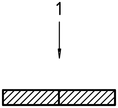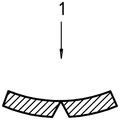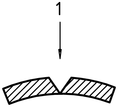OIN 6603-1-2000 “Plastiques – Détermination du comportement à l'impact par perforation des plastiques rigides – Partie 1: Tests d'impact non instrumentaux”
introduction
OIN (Organisation internationale de normalisation) est une alliance mondiale d'organismes de normalisation nationaux (Comités membres de l'ISO). L'élaboration de normes internationales est généralement réalisée par l'intermédiaire de comités techniques ISO.. Chaque institution membre intéressée par un sujet pour lequel un comité technique a été créé a le droit d'être représentée au sein de ce comité.. Les organisations internationales gouvernementales et non gouvernementales en liaison avec l'ISO sont également impliquées dans ces travaux.. L'ISO travaille en étroite collaboration avec la Commission électrotechnique internationale (CEI) sur toutes les questions de normalisation électrique.
Les normes internationales sont rédigées conformément aux règles données dans la partie 3 de la directive ISO/CEI.
Le projet de norme internationale adopté par le Comité technique sera distribué aux comités membres pour vote.. La publication en tant que norme internationale nécessite l'approbation d'au moins 75% des établissements membres.
Veuillez noter que certains éléments de cette partie de l'ISO 6603 Peut faire l'objet d'un droit de brevet. L'ISO n'est pas responsable de l'identification de tout ou partie de ces brevets..
La norme internationale ISO 6603-1 was developed by the Technical Committee ISO/TC61, Plastiques, Sous-comité SC 2, Propriétés mécaniques.
OIN 6603-1-2000 “Plastiques – Détermination du comportement à l'impact par perforation des plastiques rigides – Partie 1: Tests d'impact non instrumentaux”
The second edition cancels and replaces the technically revised first edition (OIN 6603-1:1985).
OIN 6603 se compose des parties suivantes, sous la rubrique générale Plastiques – Détermination du comportement à l'impact par perforation des plastiques rigides:
– Partie 1: Tests d'impact non instrumentaux
– Partie 2: Essais d'impact instrumentés
Appendix A of this part of ISO 6603 is for information purposes only.
1 Gamme
This standard specifies a method for determining, under specified conditions, the puncture impact properties of rigid plastics in the form of flat specimens, such as disks or squares. The sample can be molded directly, cut from the sheet or removed from the finished product. Different types of samples and test conditions are defined.
OIN 6603-1-2000 “Plastiques – Détermination du comportement à l'impact par perforation des plastiques rigides – Partie 1: Tests d'impact non instrumentaux”
These drop dart methods are used to study the behavior of plastic films or molds under the impact of a firing pin perpendicular to the specimen plane.
Cette partie de l'ISO 6603 can be used if it is sufficient to characterize the impact behavior of plastics by an impact failure energy threshold based on many samples. If a force-deflection or force-time plot recorded at a nominal constant firing pin speed is necessary to characterize impact behavior in detail, OIN 6603-2 is used.
These test methods are suitable for specimens with thicknesses between 1 mm et 4 mm.
Note For thicknesses less than 1 mm, OIN 7765 est recommandé. If the equipment is suitable, it is possible to test thicknesses greater than 4 mm, but this test falls outside the scope of ISO 6603-1 et ISO 6603-2.
These methods are suitable for the following types of materials:
Rigid thermoplastic molding and extrusion materials, including filled, unfilled and reinforced compounds and sheets;
– Rigid thermosetting molding and extrusion materials, including filling and reinforcing compounds, sheets and laminates;
OIN 6603-1-2000 “Plastiques – Détermination du comportement à l'impact par perforation des plastiques rigides – Partie 1: Tests d'impact non instrumentaux”
Fiber-reinforced thermoset and thermoplastic composites, including unidirectional or non-unidirectional reinforcement materials, such as MATS, woven fabrics, woven roving, cut strands, combined and mixed reinforcement materials, roving, milled fibers and sheets made from pre-impregnated materials (prepregs).
These methods are also applicable to samples molded or machined from finished products, laminates and extruded or cast plates.
The test results are comparable only when the preparation conditions, size and surface of the sample and the test conditions are the same. En particulier, the results determined on specimens of different thicknesses cannot be compared with each other (see Appendix E: – to ISO 6603-2). A comprehensive assessment of the impact stress response requires measurement of the impact velocity and temperature of different material variables, such as crystallinity and moisture content.
The impact behavior of the finished product cannot be predicted directly from this test, but samples can be taken from the finished product (see above) for testing by these methods.
Test data developed through these methods should not be used in design calculations. Cependant, information on the typical behaviour of the material can be obtained by testing at different temperatures and impact velocities (see Annex D of ISO 6603-2: -), varying thickness (see Annex E of ISO 6603-2: -) and testing samples prepared under different conditions.
Cette partie de l'ISO 6603 describes two statistical test methods:
– Méthode A: Staircase Method (Individual) (preferred)
In this method, a uniform energy increment is used during the test. After testing each sample, the energy is reduced or increased by uniform increments, depending on the observations (pass or fail) of the previous test.
OIN 6603-1-2000 “Plastiques – Détermination du comportement à l'impact par perforation des plastiques rigides – Partie 1: Tests d'impact non instrumentaux”
– Méthode B: Group method (Facultatif)
In this method, a continuous group of at least ten samples is tested. The impact failure energy is calculated statistically.
2 Références normatives
Les documents normatifs suivants contiennent des dispositions qui, par référence ici, constituent les dispositions de la présente partie de l'ISO 6603. Pour les références datées, toute révision ou modification ultérieure de ces publications ne s’appliquera pas. Cependant, Parties aux accords basés sur cette partie de l'ISO 6603 sont encouragés à étudier la possibilité d'appliquer de nouvelles versions des documents normatifs suivants. Pour les références non datées, une nouvelle version du document normatif visé s'applique. Les membres de l'ISO et de la CEI tiennent un registre des normes internationales actuellement en vigueur.
OIN 291:1997, Plastiques. Adjust and test the standard atmosphere.
OIN 293:1986, Plastiques. Compression forming sample of thermoplastic material.
OIN 294-3:1996, Plastiques. Injection molding of thermoplastic material samples. Partie 3: Small board.
OIN 295:1991, Plastiques. Compression molding of thermosetting material samples.
OIN 1268:19741), Plastiques – Preparation of glass fiber reinforced, resin bonded, low pressure laminates or panels for test purposes.
OIN 2818:1994, Plastiques. The sample was prepared by machining.
OIN 7765-1:1988, plastic films and sheets. The impact resistance was determined by the free falling dart method. Partie 1: Staircase method.
OIN 7765-2:1994, plastic films and sheets. The impact resistance was determined by the free fall dart method. Partie 2: Instrumental puncture test.
OIN 6603-1-2000 “Plastiques – Détermination du comportement à l'impact par perforation des plastiques rigides – Partie 1: Tests d'impact non instrumentaux”
3 Termes et définitions
Pour les besoins de cette partie de l'ISO 6603, les termes et définitions suivants s'appliquent:
3.1 Aperçu
3.1.1 Failure
Any visible breakage of the specimen surface
3.2 Failure standard terms
3.2.1 Crack
Any cracks that are visible to the naked eye and cannot penetrate the entire thickness of the material
Voir: Chiffre 1
3.2.2 Broken
Any cracks throughout the entire thickness of the material
Voir: Chiffre 2
3.2.3 Pénétration
Failure of the firing pin to penetrate the entire thickness of the specimen
Voir: Chiffre 3 b)
3.2.4 Grinding
Break the sample into two or more pieces
Voir: Chiffre 3 un)
3.3 Impact failure items
3.3.150 % impact failure energy E50
The energy that causes 50% of the sample to fail, as defined in 3.1.1
3.3.250 % impact failure mass M50
The mass that causes 50% of the sample to fail at a given fall height, as defined in 3.1.1
3.3.350 % impact failure mass H50
50% impact failure height H50 uses the height at which a given falling mass causes 50% sample failure, as defined in 3.1.1
Chiffre 1 – Specimen sections damaged by “fissures” [b) and c) after bending by hand
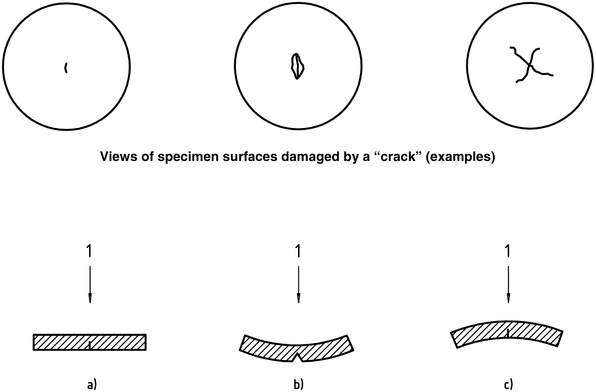
| 1 | Impact direction |
OIN 6603-1-2000 “Plastiques – Détermination du comportement à l'impact par perforation des plastiques rigides – Partie 1: Tests d'impact non instrumentaux”
Chiffre 2 – Slices passed through the specimen are damaged by “breakage” [b) and c) after bending by hand
| un)
| b)
| c)
|
| 1 | Impact Direction |
Chiffre 3 – Examples of “broken” failures [un) et “penetrated” [b)
un)
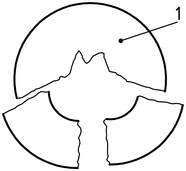
b)
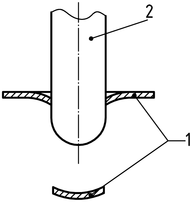
| 1 | Specimen |
| 2 | Darts with hemispherical heads |
Seule la section d'informations standard est publique. Pour voir le contenu complet, vous devez acheter la norme via les canaux officiels.

